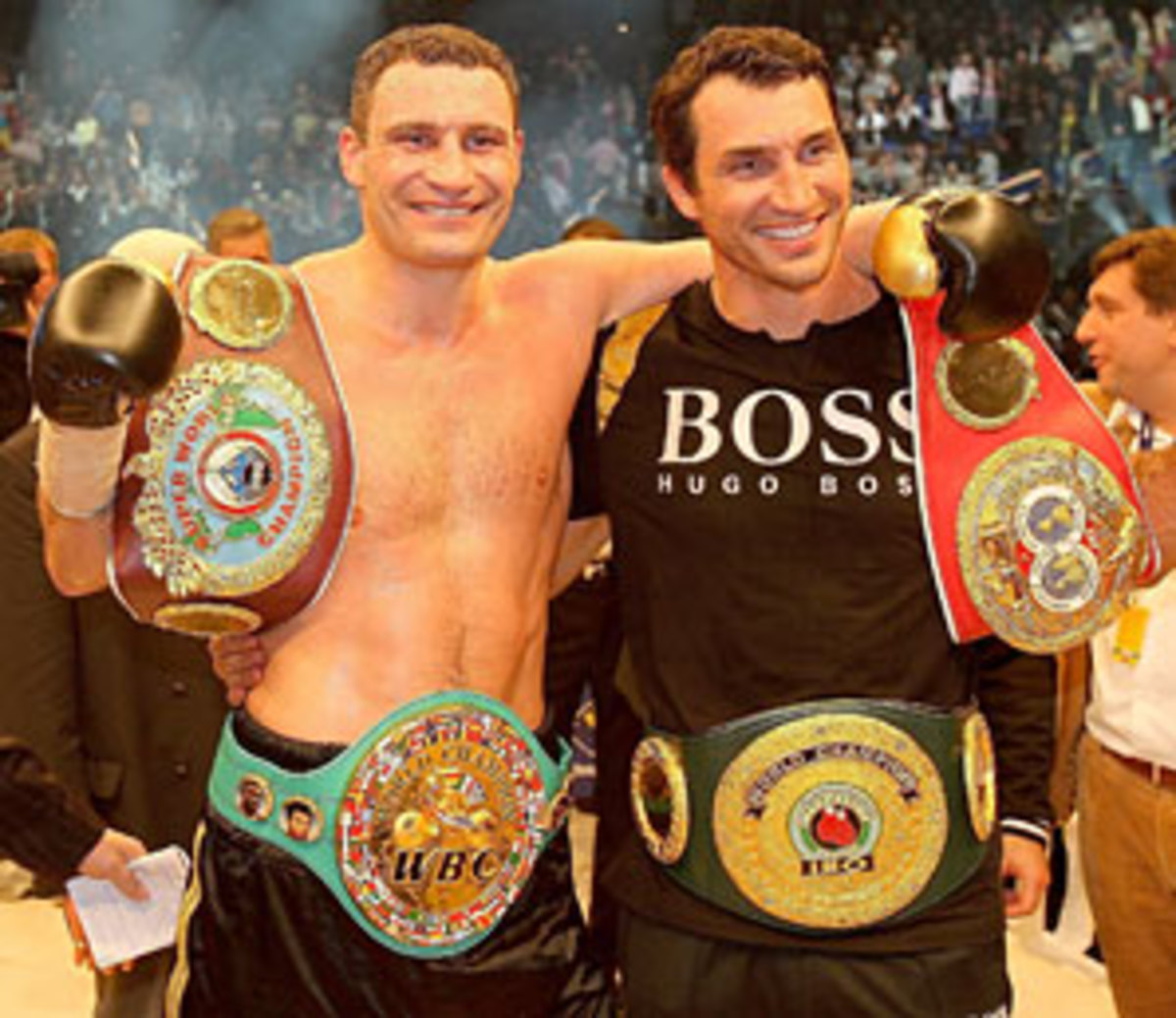My Sportsman: The Klitschkos


Sports Illustrated will announce its choice for Sportsman of the Year on Nov. 30. Here's one of the nominations for that honor by an SI writer.
Wladimir and Vitali Klitschko aren't your typical modern-day athletes. They don't have tattoos or reality shows, fragrance lines or rap sheets. They certainly don't have cool nicknames (Dr. Steelhammer and Dr. Iron Fist, respectively). They don't appear to know a TMZ from a TKO.
All they've done is become the first pair of brothers to hold pieces of the world heavyweight championship at the same time. That alone might warrant Sportsman of the Year consideration, if they didn't already embody the classical definition of sportsman so completely.
Mind? Both have Ph.D.s, speak four languages and play chess avidly, a brand of renaissance overachievement not seen in pro sports' uppermost flights since Bill Bradley.
Body? Vitali (6-7, 250) and Wladimir (6-6, 240) have been models of masculine perfection throughout their careers and longtime advocates of physical education to foster confidence and hope among young people. "It's never tough to get in shape," Vitali, 38, told reporters before a September KO of Chris Arreola. "I don't drink, don't smoke, don't do drugs. I always, always maintain fitness."
Spirit? It seems awfully obtuse to pin the alleged death of boxing on the heavyweight division when the Klitschkos are selling out soccer stadiums in Europe. More than 61,000 fans packed Germany's Veltins-Arena for Wladimir's ninth-round TKO of Ruslan Chagaev in June -- the largest-ever indoor attendance for a fight on the continent. They've won even more hearts with their charitable works through the United Nations Educational, Scientific and Cultural Organization, along with other humanitarian efforts too numerous to recount here.
Wladimir (53-3, 47 KOs) is the superior fighter today and, at 33, insists that he's entering the prime of his career. He consolidated power with the Chagaev victory, adding the Ring magazine title to his IBF and WBO belts. It's been more than five years since he lost a fight.
Vitali (38-2, 37 KOs), who holds the WBC title, rates better in the history books: He has never been knocked down or taken a standing eight count and boasts the highest knockout rate of any heavyweight champion (92.5 percent). It's not a stretch to suggest that he would still be undefeated if not for bad luck with injuries: Both of his losses came on injury stoppages while he was ahead on the scorecards.
They seldom talk trash, even if provoked. When David Haye wore a T-shirt depicting the dismembered heads of the brothers and made reference to "Wladimir Bitchko" before pulling out of their June fight with an injury, the champion responded with candor and dignity. "My feelings are embarrassment that such a personality is involved in the sport. I cannot accept it," Wladimir said. "Boxing is international -- it has one race, one language and this is performance."
The breadth of their achievement is almost... annoying. You can practically hear your mother over breakfast: Why can't you be more like those Klitschko boys?
Yes, they're boring. But so is glacial formation, plate tectonics and the process through which coal becomes diamond. The workmanlike Klitschkos don't feed the tabloid machine. In the ring, they don't overthink it, don't play for style or try to be something they're not. Their biggest strength is a realistic knowledge of their own weaknesses. Most of their fights conform to a familiar pattern: They press the size advantage to measure distance and tenderize the challenger early with left jabs and straight rights. There's a knockdown or two along the way before the fight ends in the middle or late rounds.
We've seen predictable, maddening efficiency in sports before. They banned the dunk for Alcindor -- a lame if earnest effort to restore competitive balance to college hoops -- but how do you handicap a boxer?
Say what you want about the moribund state of their division, but fight fans have complained about the lack of great heavyweights in almost every era of boxing. Rocky Marciano, Larry Holmes and Mike Tyson didn't exactly cut their teeth on a parade of in-their-prime legends. Our country's most beloved heavyweight champion -- Joe Louis -- feasted on what sportswriter Jack Miley dubbed the "Bum of the Month club."
In our insular sporting culture, a sport is seldom popular if an American isn't the best. Men's tennis was hot when Andre Agassi, Jim Courier and Pete Sampras took turns atop the ATP rankings: Eighteen times the sport was featured on the cover of Sports Illustrated during the '90s, compared to just four times in the nine years since. Soccer, the world's most popular game by light-years, remains a cult sport in the U.S. as long as our national side is second-rate. If we're not the best at it, goes the thinking, it's probably not worth following.
The sweet science is a victim of the same trend, as the shortage of American heavyweight contenders -- coupled with the rise of homegrown alternatives like mixed martial arts -- pushes the sport further toward the periphery. Yet there would be far less hand-wringing about boxing's vitality if the Klitschkos came from Yonkers and not Ukraine.
Agree with this selection? Tell us your Sportsman pick here.
